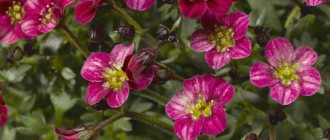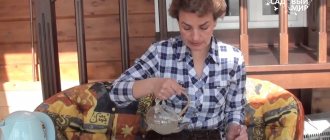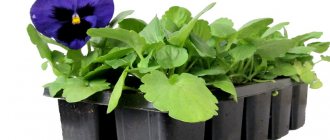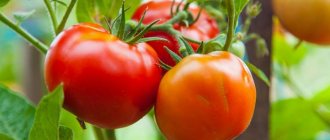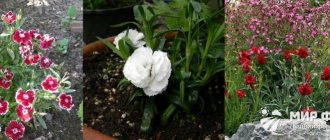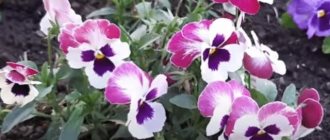Fragrant (winged) tobacco is an elegant and wonderful relative of smoking tobacco. This annual crop is distinguished by delicate pastel flowers and a stunning, spicy aroma. Ideal for those who like to enjoy not only the beauty of plants in the garden, but also their smell. You can plant flowers in a flowerbed in open ground, in flower pots, or in balcony boxes. It is very convenient to grow crops from seeds at home, and then plant the plants in the garden.
What is fragrant tobacco and how does it differ from smoking tobacco?
The genus of fragrant tobacco (from Latin Nicotiana alata) belongs to the plant species of the Solanaceae family. According to its plant characteristics, tobacco is included in the family of dicotyledonous spinoletal plants such as tomatoes, potatoes, and eggplants. This species has several names, for example, “winged”, “Athenian”. In Europe, fragrant tobacco appeared after smoking varieties and shag. In the second half of the 19th century, bushes with this plant could be found in gardens, flower beds and parks.
Fragrant tobacco contains phytoncides - biologically active substances that affect and stop the growth and development of bacteria and fungi. Phytoncides can protect not only tobacco, but nearby plants near the bush from parasites. Experienced gardeners, knowing this property of the plant, protect their garden from parasites without the use of chemicals.
There is a certain pattern - when the color of tobacco flowers is too bright, the aroma will be weakly expressed. If the buds are light, the smell will be stronger.
The simplest type of tobacco began to spread in 1753 thanks to the ambassador Jean Nicot from Portugal, who brought powdered tobacco to France as a medicine for migraines. In honor of Jean Nico, tobacco itself was named in its pure form - Nicotiana. Thanks to the ambassador, the British began to distribute tobacco to various countries around the world after 1565. For 150 years, tobacco grew throughout Eurasia and the African continent.
A couple of interesting facts about the plant:
- by 1600, commercial tobacco plantations appeared in Spain, or rather in the colonies;
- In 1612, John Rolfe in the English colony of Jamestown (Virginia) harvested for the first time. This tobacco was christened Virginia;
- tobacco became one of the main export products from Virginia. It was used by the colonists as local currency.
This plant does not have smoking qualities (it does not contain nicotine), but remains a flower that pleases only with long flowering.
It grows in the form of bushes of medium diameter and height. Tobacco stems are strong and flexible. The trunks of the bushes are decorated with branches with large leaves with pointed tips. The length of the root system is up to 2 m. The flowering of fragrant tobacco buds is accompanied by a paniculate inflorescence. Seed pods belong to the fruiting parts of the bush. When ripe, the boxes crack.
Types, varieties
The term “fragrant tobacco” itself combines several types of plants. All of them are from the Paslenov family:
- Forest tobacco - with white flowers, reaches 80-150 cm. A dwarf variety measuring a quarter of a meter has recently been bred;
- Langsdorf - with dark green bells, bush height 120 cm;
- Sander tobacco - popular varieties: Tuxedo Lime with yellow flowers, and Tuxedo Samen-Pink with salmon-colored flowers;
- Dolce Vita - varieties of the species are distinguished by the variety of colors of the blossoming buds, which open throughout the day;
- Green Light - grows up to half a meter, has yellow flowers with a light green tint;
- hybrid Pleasure - about a meter tall, with raspberry-colored flowers, quite tolerant of drought;
- Winged tobacco is distinguished by an abundance of varieties.
When to plant seeds for seedlings
Tobacco species, including fragrant, can only be propagated by seeds. Flowers reproduce by self-seeding, so young tobacco can be found in any part of the site. If you want to avoid chaotic seed germination, then do not forget to remove flaccid parts of the plant, for example, buds or leaves, during care. For planting, you can use “mother” seeds or purchased from gardening.
If you want to preserve the bush for the coming year, then before frost, transplant it into a large pot and grow it at home. In the spring, the tobacco bush can again be transplanted into the ground on the site. In this way, you can turn annual bushes into perennial ones.
Since the plant loves warmth and moderate moisture, it is important to start planting in the soil prepared on the site with the onset of absolute spring heat, since frosts can kill the plant. For the south, planting can begin from the end of March until the beginning of May. In cold regions, planting approximately begins from May to June. To achieve germination, the seeds should be germinated first in late winter or early spring.
It is recommended to plant seedlings at a distance of 30 cm. Each bush must germinate in free space in order for the root system and branches to develop correctly.
Fragrant tobacco does not require personal care. It blooms with eye-catching flowers, and its leaves have sharp tips and are wide near the stems, giving the bush volume. Tobacco can germinate in different soil compositions – even ones that are not very favorable for other nightshade crops. Tobacco easily adapts to bright sun. However, it is better to plant it in the shade.
First shoots
After half a month, sprouts will appear. The boxes with seedlings are moved to a room with t +16o C, and the cover is removed. When 2-3 strong leaves appear, the sprouts are dived into separate cups:
- water the soil before planting;
- remove the plant without shaking off the soil from the small roots;
- and place separately in prepared containers.
Water sparingly, do not overwater, do not let it dry out.
Before planting fragrant tobacco on the plot, it is hardened for two weeks - every day it is briefly exposed to the yard, gradually increasing the time.
Planting seeds
Sowing seeds should only be done in prepared soil with a peat layer. You can mix peat with humus and soil. The ratio of different types of soil should be equal. The container for planting needs to be shallow. Before planting the seeds in the ground, you should keep them in a wrapped damp cloth for a maximum of two days, but it is important to ensure that they do not germinate in the material.
14-15 days after sowing, sprouts can already appear, which will grow only on a sufficiently lit windowsill without covering with film.
The seeds are small in size, so they need to be distributed throughout the soil with special attention. After watering with a sprayer, containers with seeds are covered with filmy material, creating a greenhouse effect. Seeds should be stored indoors at temperatures between +20 and +22 C.
Seed preparation
Transplantation into open ground can be successful after hardening the seedlings at home. First of all, place the pots in the fresh air for 50 minutes (possibly on the balcony), gradually increasing the length of time outside.
Planting in soil in a vegetable garden or garden is less preferable than pre-growing seedlings. Seedlings are prepared taking into account the time reserve, since tobacco needs to be planted in the garden when stable warmth arrives in the spring. If the climate is warm, seedling preparation begins in February; when climate conditions are cold, later in March. For central Russia, seedling preparation begins from mid-January to the third decade of March. Young bushes are transplanted into the soil when the earthen composition of the soil warms up sufficiently.
To evenly distribute small seeds in the pots, it is recommended to mix soil with sand 1:1. To improve germination, it is recommended to pre-soak the seeds in water so that they swell. You can also purchase pelleted seeds that can be planted individually in small trays. It is enough to place one granule in the center of the cup. After sowing, water the soil generously in glasses, the main thing is to water it carefully using a spray bottle.
Soil preparation
Transplantation can be most successful using the earthen clod transfer method. A distance of 20-30 cm is ideal when planting seedlings of this type of tobacco bush.
It is important to maintain uniform mixing of soil substrates in equal proportions:
- peat composition;
- humus;
- land from the area where it is planned to plant bushes.
Selection of capacity
To germinate tobacco seeds, you should select low containers with sides of about 7 cm. In such flat trays, the seeds will sprout on time. To grow seedlings, it is advisable to sow the seeds in a wooden or plastic box. Bowls, plastic glasses, peat containers, plastic cassettes, and peat tablets are also suitable. Drainage is not needed only in peat pots and tablets, but in other cases its presence is important.
A convenient option is to plant tobacco seeds in a wide and shallow container up to 10 centimeters high. It turns out that the tobacco seeds are too small, and using a common container allows them to be evenly distributed over the surface. In the future, picking will be significantly easier. Granulated seeds are larger in size than standard ones, so it is better to plant them separately in plastic or peat cups.
Sowing seeds
After preparing the seeds, you can begin planting in a special soil composition. To grow a tobacco plant, it is important to adhere to the current planting scheme:
- Take cleaned sand from the river. It can be heated in a frying pan and cooled. Pour a small handful of it (about 2 tablespoons) onto a bowl. Sprinkle the seeds on top of the sandy soil. Distribute the planting material into containers and lightly press the surface of the soil layer without crushing it with soil.
- Moisten the top of the soil with water. It is advisable to water the seeds using a spray bottle. Experienced gardeners also advise watering tobacco seeds after sowing, preferably through a tray. If you water it with a spray bottle, the seeds may sink too deeply into the soil.
- Pour a small amount of clean hot water into the bowl - the seeds will activate faster in this case. It is recommended to do this by spraying so as not to splash the small seeds.
- Cover the containers with plain cling film.
- Place the containers with seeds in a place where it is warm, dry and light. Also, the same temperature regime should be maintained at the place where the seedlings are placed - 22-23 degrees Celsius. To create a greenhouse effect, you need to cover the container with the plants with film.
- Until the seedlings appear, the soil should be kept moist. Water every 2 days.
It is necessary to plant only with a clod of earth in which the seed has sprouted. Replanting is carried out after moistening the soil composition. To make early tobacco more seasoned, it is recommended to maintain a temperature of +18C. Before replanting, pinch the tops and fertilize the soil. After sowing, it is important to keep the soil moderately moist.
How to care for fragrant tobacco seedlings
First of all, in order for the seedlings to be strong and not to die in the open ground, it is necessary to adjust the lighting, temperature conditions, regularity of watering, and, if necessary, arrange additional lighting.
Secrets of properly caring for the nightshade plant:
- Maintain a constant temperature of +23 degrees Celsius. When the shoots appear, you can maintain a low temperature of up to +18-20C.
- Water frequently through the tray. You can also water with a spray bottle, but in this case the pressure should be gentle and weak so as not to damage the still immature seedlings.
- Before emergence, ventilate the greenhouse space once a day. This can be done in the evening or in the morning - first remove the film or lid from the container with the seedlings. It is important to keep the seedlings open for no more than 20 minutes. After ventilation, remove drops of condensation from the surface of the covering material.
- After the first shoots appear, remove the covering material. The seedlings now have a place in a well-lit area in the house. Ideally, a south or southwest window sill would be suitable.
- With the help of phytolamps, you can add light to the bushes if spring is early and there is not enough sunlight. You can also use LED grow lights to add light to your plants.
- The distance from the light source should be 5-10 cm. If there is a lack of light, then the trunks are pulled out. Externally, the stem becomes suspiciously long. You can add additional light to the bushes in the morning or evening, when it is not sunny or cloudy outside.
- For early seedlings, watering from a spray device can be dangerous. The stream of water bends the stems, and weak plants may break. After germination of the seedlings, it is better to water the tobacco through a tray. Plants themselves absorb the required amount of water.
Watering
Watering frequency is important during hot seasons for growing tobacco. In the hot and dry summer heat, the tobacco procedure requires watering every day. If the summer is not sunny, but rather rainy, then you need to water less often - on warm days.
Do not allow the soil to become dry. Watering depends not only on the individual type of tobacco, but also on the specific climate where it is planted. You can water in the morning or evening to maintain natural soil moisture.
Top dressing
This type of tobacco does not need to be fed with mineral compounds too often. It is enough to fertilize the bushes up to 3 times a season. The first feeding is carried out when the buds are ripening, and the second right before the flowers open. Phosphate fertilizers for feeding during flowering are the most gentle and effective. A high nitrogen content in the fertilizer may develop beautiful foliage, but will negatively affect flowering - there will be fewer buds.
To achieve long-lasting charming flowering, you should not forget to fertilize the soil during the two periods of bud formation. The first feeding is carried out with the emergence of new buds, and the second - when the flowers bloom.
Phosphate fertilizers are most suitable for saturating the soil - according to experienced gardeners. If the mineral fertilizer contains a lot of nitrogen, the foliage will grow and flowering will be poor.
Picking
The first shoots will appear 13-14 days after planting. To prevent the sprouts from stretching excessively, it is important to illuminate them with an artificial ultraviolet source. During the same period, you can slightly open the greenhouse layer to acclimate the plants to the temperature in the apartment or house. First, the greenhouse can be opened slightly by 10 mm, and then this distance can be increased.
Picking can be done when the bush has formed 2-3 leaves. After the seedlings receive a good amount of water, very carefully remove the seedling from the container along with the lump of earth. Plant them in personal cups made of peat or plastic. After this, pinch the tops of the bushes so that they grow fluffy and voluminous. Water the seedlings after pinching.
Start picking as soon as the plant shows activity and produces several leaves:
- Pre-irrigate the soil composition.
- Carefully remove the seedling along with a lump of earth. Move it into a container separate from the rest of the seedlings.
Planting seedlings in open ground
In cold climates, tobacco seedlings can be planted in the second ten days of May. In the southern regions, planting seedlings can begin as early as April. By the time young bushes are planted on the site, the soil should already be warmed up. The occurrence of frost should be reduced to 0% at this point. Of course, the seedlings are hardened in advance, but they will not be able to withstand strong temperature changes. During a period of 14 days, the seedlings are transferred outside for 1 hour every day.
In the first 10 days, it is enough for the bushes to stay outside for 60 minutes. Next, gradually increase the time in the fresh air until the seedlings get used to the changed climate. After a regular hardening process, the bushes can be planted in open ground.
When planting bushes in holes in the garden or garden, it is important to maintain a moderate distance. There should be 200-300 cm of free space between the bushes. Before sending the bushes into the holes, add superphosphate to the ground. Place the plant prepared for planting in the hole and cover it with soil. The top layer of soil around the bushes should be compacted, but do not press it too hard with a shovel - this is necessary so that the moisture is evenly distributed throughout the soil.
When to plant fragrant tobacco in open ground
Fragrant tobacco is still a heat-loving plant, and in this regard, experienced gardeners recommend that beginners plant and improve the bushes only after sowing the seeds at home and growing seedlings for 1-2 months. The last days of the February winter or the beginning of March are the time to sow seeds at home, but for open ground it is better to wait until the last month of spring.
Information! Plant the grown seedlings in the ground in a garden bed with the soil fully warmed up. During this period, there should be no sudden frosts or sudden climatic changes. In spring, the weather stabilizes in May - this is the time for planting in the ground outside.
Choosing a place
For planting tobacco bushes, a spacious plot of land is ideal, which is moderately protected from direct rays of the sun and from wind gusts. Ornamental tobacco is easy to care for, and the composition of the soil for planting it can be any. However, the earthen composition must be moist and preferably nutritious. If the soil is too scarce, then in the autumn it is better to dig it up so that it is mineralized for the next year. Before planting, you need to add humus or compost to the soil, as well as a drainage layer.
When planting small bushes in open soil, distance should be maintained. The distance from one to the second bush should be 0.2–0.3 m. If you plan to plant tall varieties of fragrant tobacco, then it is better to increase the distance to 300 cm. Tall varieties of tobacco reach a height of up to 1 meter. At first, the seedlings will be almost leafless, but tall. They can also spread along the ground, but in this case it is better to tie them up.
Description of the plant
Let's talk a little about the name of the fragrant plant. It is also called Decorative or Winged Tobacco . The Latin name for fragrant tobacco is very interesting - Nicotiana suaveolens , but there is also a second name in Latin - Nicotiana alata (that is, Winged Tobacco).
It cannot be smoked; it serves only a decorative and aesthetic function. It is often used to decorate gardens and landscape design, for example, to decorate alpine slides and rockeries. Gardeners who love aromatherapy will definitely like this flower crop.
By the way! The fragrance of a decorative flower begins in the evening and at night, and is also possible during the day, in cloudy weather.
The flowers have a diameter of about 6-8 centimeters. Among them there are different shades: white, yellow, light green, lilac, pink, red and others. With proper care of fragrant tobacco in open ground, flowering lasts from early summer to September.
By the way! Experienced flower growers have discovered an interesting pattern - the most fragrant and aromatic tobacco is the one that has white flowers or flowers of other light shades. But bright plants smell much weaker.
There are several types of fragrant tobacco:
- Low-growing (dwarf) - height up to 30 centimeters, ideal for decorating borders, rock gardens, rockeries, balconies.
- Medium-sized - from 30 to 70 centimeters; it is optimal to grow this variety around terraces and gazebos.
- Tall - the height of plants is from 80 centimeters, they look most interesting next to the walls of buildings, fences, behind flower beds that combine low and tall plants.
Do you know why else gardeners and flower growers love fragrant (winged) tobacco? It is a natural insecticide that repels pests from itself and from other crops in the garden - vegetables, berries, fruits. The flower is especially effective against Colorado potato beetles.
If you want to feel the whole palette of aromas of this amazing annual plant, then it is recommended to plant it in the garden in places where you often stay, for example, near a gazebo, hammock, bench, or entrance to the house.
Caring for fragrant tobacco in open ground
There are no complicated rules in growing this tobacco plant variety in a garden plot. Tobacco requires regular watering, weeding, and feeding. The soil also needs to be constantly improved. The soil around the bushes should be carefully loosened and treated against parasites and diseases. To ensure that the bushes always look fresh and well-groomed, it is important to regularly pick dried flowers and fading buds.
After planting the bushes, the area should be provided with abundant watering - this can be done using automatic devices. On hot summer days and dry periods, watering should occur every day. If the summer is rainy, then watering can be reduced.
After the development of inflorescences begins, it is important to maintain regular watering and feeding. It is not recommended to introduce nitrogen into the soil in large quantities, since the bushes will begin to turn sharply green due to the active blossoming of leaves, but the buds will not receive proper nutrition. If the tobacco bush grows in fertile soil, then fertilizing is not necessary.
In the fall, experienced gardeners advise digging up tobacco bushes if you want the plant to bloom the following year. The bushes are planted in pots and brought into the house, shortening the shoots by one third. Tobacco should be placed in a room with a lot of light, and watered as the soil dries. With the onset of spring warmth, it can be planted outside again.
Some interesting facts about the tobacco plant from the nightshade family:
- under the general name “fragrant tobacco” different types of Solanaceae are united;
- if the seedlings in a greenhouse are infected, the young foliage will turn greenish-yellow and the edges of the leaves will bend down;
- Parts of the bush damaged by infection or parasites must first be cut off and then burned in a fire. In this case, the parasites will not spoil other plants;
- the ground around the tobacco needs to be disinfected with a 7.5% formaldehyde solution. Calculation of liquid 30 liters per 1 sq. m. mixture from soil;
- clayey or too dense soil structure should be fertilized with humus and compost before planting;
- faded inflorescences do not in any way affect the intensity of the formation of new buds;
- most varieties of fragrant tobacco open their buds in the late afternoon;
- In winter, tobacco is in a dormant stage, so it does not need to be watered too often.
Collection and storage rules
Even while tobacco is blooming, it is necessary to prepare for collecting seeds. This is important for further cultivation of the crop. The seeds are in the fruit box. After the box ripens, it is cut off and left to dry for 2 weeks. After this, you can remove the seeds from it.
Leaves can be removed when they turn yellow. Collection begins from the lower rows, and continues as the upper tiers ripen. They take off as much as they can collect. The main thing is that each sheet is intact. After planting in open soil, the bushes mature in 1.5 months. This means that the first leaves are collected from mid-June.
Once collected, the leaves are dried and fermented.

